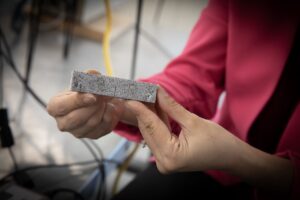A cliff face may be a symbol of serene solidity, but that mental image can violently change in an instant. After millions of years of weathering, tectonic shifts, and the relentless pull of gravity, it can be anyone’s guess as to where and when a boulder will dislodge itself from a rock slope and wreak havoc below.

Shahrzad Roshankhah, assistant professor in the Department of Civil & Environmental Engineering, is not content with guesses.
Rock slope failures are uniquely dangerous, not only to anything that might be in the path of the debris, but to infrastructure above the incident as well, which may be compromised if not outright destroyed. Roshankhah’s research aims to make construction around rock slopes safer and more predictable by better quantifying the factors that go into these disasters.
Roshankhah has recently been awarded a National Science Foundation (NSF) CAREER Award to advance the understanding and quantification of the behavior of jointed rock slopes. Quantitative analyses, empowered by a combination of physical and digital modeling, will reveal the hidden dynamics of fractures within jointed rock slopes, taking some of the guesswork out of predicting when and where a collapse is likely to happen.
“Predicting the stability of such slopes is difficult due to the complex interactions between the rock matrix and natural fractures,” Roshankhah says. “Traditional models often oversimplify these interactions, averaging properties of the rock mass, failing to account for the distinct roles of the rock matrix and natural fractures in instability, and thus overestimating the safety margins leading to inadequate risk assessments.”
So how does one take a look inside a hunk of rock bigger than a house? First, by shrinking the system down to a more manageable size.
The specific terrains that Roshankhah studies are known as jointed rock systems; these are large masses of rock that have fractures, or joints, running through them. Roshankhah and her students make accurate scaled models of jointed rock slope systems — small enough to fit on a tabletop — and experiment on them using material properties and environmental conditions that are equally scaled down.
“Even with a completely different material, we know how to do the dimensional analysis to make it resemble a specific rock mass,” Roshankhah says.

Using ceramic and metal 3D printing, Roshankhah’s team crafts sample rock blocks and assembles them to form small scale rock slopes. Then, they use strong magnets to pull down on the sample, simulating the gravitational forces on a real-life scale rock slope. Different modes of failure are triggered in the model slopes while a high-speed camera captures how the failure process begins and evolves.
Roshankhah’s team analyzes the images to track the changes in a speckle pattern printed on the rock blocks to pinpoint the exact mechanical deformations in play. Several acoustic emission sensors provide additional dimension of information on the evolution of the fracture network.
“We can literally hear the stress waves coming off a generated crack,” Roshankhah says. “We can then use the wave’s arrival time and the speed at which it propagates in the given material to figure out where and in what mode the fracture was formed.”
Roshankhah’s group is already conducting experiments with rock samples but is currently applying them to geological systems found deep underground under very high stresses. This is relevant to energy and environmental geo-systems, such as deep geothermal energy and geological storage of carbon dioxide and hydrogen. The CAREER Award project will be built on those experiences, but apply them to jointed rock slopes that are found on the earth’s surface under relatively lower stress conditions. Such slopes are ubiquitous; they’re readily seen on the sides of highways cut through mountainous terrain, for example.
Better modeling of these slopes is critical for predicting if, when, and how they will fail.
“If you know where the fractures are inside an intact block, and can then tell if they are splitting, shearing or sliding, then you will know something about the size distribution of the blocks that will be crumbling down upon the slope failure,” Roshankhah says. “And from there, you can tell something about the distance they will travel and what civil infrastructure is at risk.”